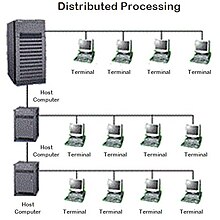Computer network
From Wikipedia, the free encyclopedia
"Computer networks" redirects here. For the periodical, see Computer Networks (journal).
Internet map. The Internet is a global system of interconnected computer networks that use the standard Internet Protocol Suite (TCP/IP) to serve billions of users worldwide.
Distributed processing
A computer network, often simply referred to as a network, is a collection of computers and devices interconnected by communications channels that facilitate communications and allows sharing of resources and information among interconnected devices. Put more simply, a computer network is a collection of two or more computers linked together for the purposes of sharing information, resources, among other things. Computer networking or Data Communications (Datacom) is the engineering discipline concerned with computer networks. Computer networking is sometimes considered a sub-discipline of electrical engineering, telecommunications, computer science, information technology and/or computer engineering since it relies heavily upon the theoretical and practical application of these scientific and engineering disciplines.
Networks may be classified according to a wide variety of characteristics such as medium used to transport the data, communications protocol used, scale, topology, organizational scope, etc.
A communications protocol defines the formats and rules for exchanging information via a network. Well-known communications protocols are Ethernet, which is a family of protocols used in LANs, the Internet Protocol Suite, which is used not only in the eponymous Internet, but today nearly ubiquitously in any computer network.
In September 1940 George Stibitz used a teletype machine to send instructions for a problem set from his Model at Dartmouth College to his Complex Number Calculator in New York and received results back by the same means. Linking output systems like teletypes to computers was an interest at the Advanced Research Projects Agency (ARPA) when, in 1962, J.C.R. Licklider was hired and developed a working group he called the "Intergalactic Network", a precursor to the ARPANET.
Early networks of communicating computers included the military radar system Semi-Automatic Ground Environment (SAGE), started in the late 1950s
The commercial airline reservation system Semi-Automatic Business Research Environment (SABRE) which went online with two connected mainframes in 1960.[2][3]
In 1964, researchers at Dartmouth developed the Dartmouth Time Sharing System for distributed users of large computer systems. The same year, at Massachusetts Institute of Technology, a research group supported by General Electric and Bell Labs used a computer to route and manage telephone connections.
Throughout the 1960s Leonard Kleinrock, Paul Baran and Donald Davies independently conceptualized and developed network systems which used packets that could be used in a network between computer systems.
1965 Thomas Merrill and Lawrence G. Roberts created the first wide area network (WAN).
The first widely used telephone switch that used true computer control was introduced by Western Electric in 1965.
In 1969 the University of California at Los Angeles, the Stanford Research Institute, University of California at Santa Barbara, and the University of Utah were connected as the beginning of the ARPANET network using 50 kbit/s circuits.
Commercial services using X.25 were deployed in 1972, and later used as an underlying infrastructure for expanding TCP/IP networks.

0 comments:
Post a Comment